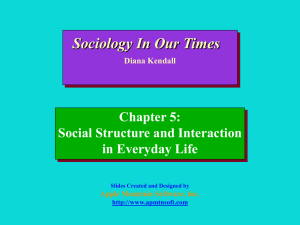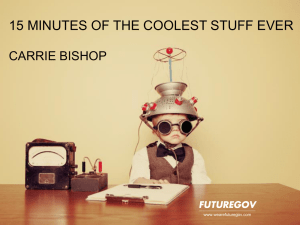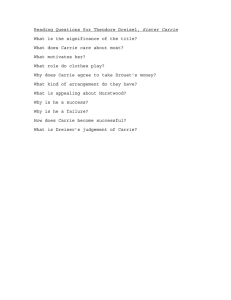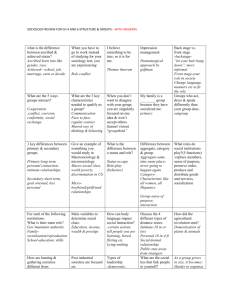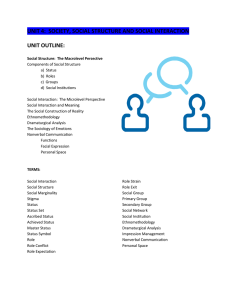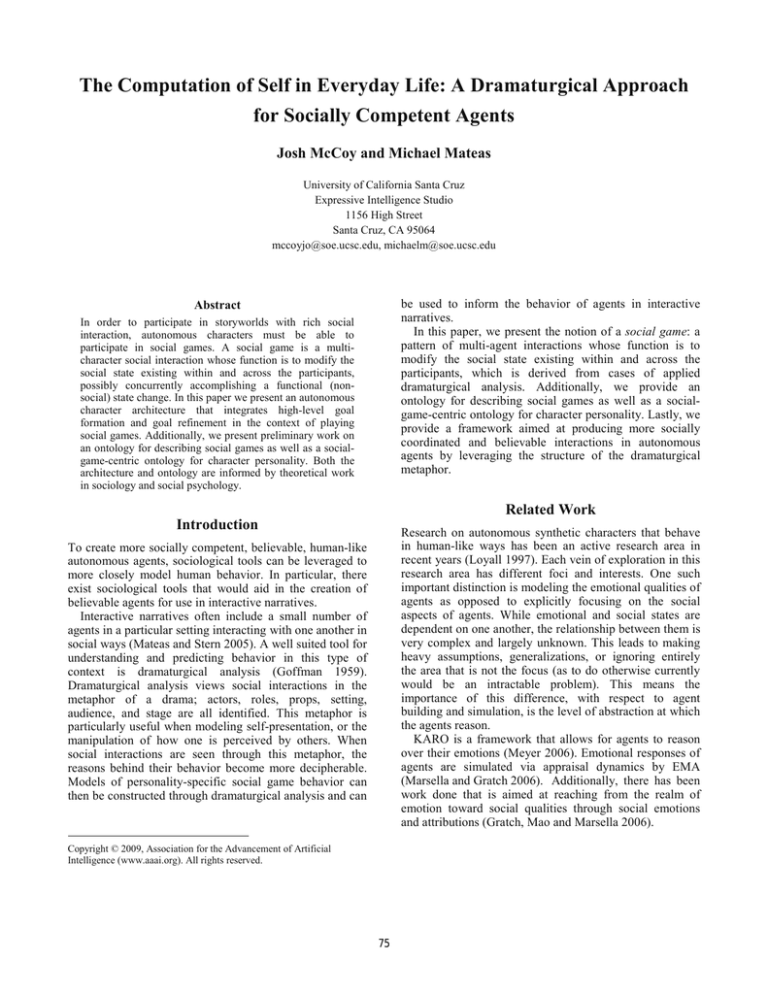
The Computation of Self in Everyday Life: A Dramaturgical Approach
for Socially Competent Agents
Josh McCoy and Michael Mateas
University of California Santa Cruz
Expressive Intelligence Studio
1156 High Street
Santa Cruz, CA 95064
mccoyjo@soe.ucsc.edu, michaelm@soe.ucsc.edu
be used to inform the behavior of agents in interactive
narratives.
In this paper, we present the notion of a social game: a
pattern of multi-agent interactions whose function is to
modify the social state existing within and across the
participants, which is derived from cases of applied
dramaturgical analysis. Additionally, we provide an
ontology for describing social games as well as a socialgame-centric ontology for character personality. Lastly, we
provide a framework aimed at producing more socially
coordinated and believable interactions in autonomous
agents by leveraging the structure of the dramaturgical
metaphor.
Abstract
In order to participate in storyworlds with rich social
interaction, autonomous characters must be able to
participate in social games. A social game is a multicharacter social interaction whose function is to modify the
social state existing within and across the participants,
possibly concurrently accomplishing a functional (nonsocial) state change. In this paper we present an autonomous
character architecture that integrates high-level goal
formation and goal refinement in the context of playing
social games. Additionally, we present preliminary work on
an ontology for describing social games as well as a socialgame-centric ontology for character personality. Both the
architecture and ontology are informed by theoretical work
in sociology and social psychology.
Related Work
Introduction
Research on autonomous synthetic characters that behave
in human-like ways has been an active research area in
recent years (Loyall 1997). Each vein of exploration in this
research area has different foci and interests. One such
important distinction is modeling the emotional qualities of
agents as opposed to explicitly focusing on the social
aspects of agents. While emotional and social states are
dependent on one another, the relationship between them is
very complex and largely unknown. This leads to making
heavy assumptions, generalizations, or ignoring entirely
the area that is not the focus (as to do otherwise currently
would be an intractable problem). This means the
importance of this difference, with respect to agent
building and simulation, is the level of abstraction at which
the agents reason.
KARO is a framework that allows for agents to reason
over their emotions (Meyer 2006). Emotional responses of
agents are simulated via appraisal dynamics by EMA
(Marsella and Gratch 2006). Additionally, there has been
work done that is aimed at reaching from the realm of
emotion toward social qualities through social emotions
and attributions (Gratch, Mao and Marsella 2006).
To create more socially competent, believable, human-like
autonomous agents, sociological tools can be leveraged to
more closely model human behavior. In particular, there
exist sociological tools that would aid in the creation of
believable agents for use in interactive narratives.
Interactive narratives often include a small number of
agents in a particular setting interacting with one another in
social ways (Mateas and Stern 2005). A well suited tool for
understanding and predicting behavior in this type of
context is dramaturgical analysis (Goffman 1959).
Dramaturgical analysis views social interactions in the
metaphor of a drama; actors, roles, props, setting,
audience, and stage are all identified. This metaphor is
particularly useful when modeling self-presentation, or the
manipulation of how one is perceived by others. When
social interactions are seen through this metaphor, the
reasons behind their behavior become more decipherable.
Models of personality-specific social game behavior can
then be constructed through dramaturgical analysis and can
Copyright © 2009, Association for the Advancement of Artificial
Intelligence (www.aaai.org). All rights reserved.
75
The application of these criteria to observations generates a
set of social games, each of which contains at least one
actor (participants in the performance who are not part of
the audience) who has a goal consisting of the set of social
state changes that result from the associated set of actions.
The dramaturgical analysis of Sex and the City helped
formalize the concept of social games. First, a group of
social interactions were observed and analyzed
dramaturgically. They were then decomposed into a list of
causally and temporally related events and a set of
dramaturgical properties. From these analyzed social
interactions, a schema for representing social games was
developed.
The schema for representing social games consists of a
description of the social game’s dramaturgical qualities,
the social and world state preconditions for the game to
start, a dependency graph of social game events, and the
state changes enacted by game completion (see figure 1).
The dramaturgical qualities consist of a list of roles and
their requirements, qualities needed in the setting, teams
among the actors, and what qualifies as an audience for the
social game. Social game events are composed of a list of
participating actors, temporal properties, actions taken by
actors, functional world change, and social facts modified
by the event. Optionally, the events can reference other
social games to create a hierarchical decomposition of
social games. Because the social effects of social games
can be different than the sum of the changes specified in its
events, the state change upon the games’ successful
completion is also represented.
Other properties of social games that resulted from the
dramaturgical analysis are that they are hierarchical and
sets of social games can be played in parallel. Furthermore,
personalities and emotional states of the actors have a great
deal of influence on the performance of the actions taken
by the actors when performing in social games. To
illustrate the results of the study, an example of a social
interactions analyzed in the study is helpful.
To begin exploring a scene in Sex and the City in a
dramaturgical metaphor, some of the more general
dramaturgical attributes need to be related to the social
situation. The setting of the performance is composed of a
wedding engagement party held in an expensive apartment
in Manhattan. The audience consists of several dozen
upper-middle class married individuals who are all in some
way socially connected to the newly-engaged couple. The
props present are objects typically found at celebrations:
champagne glasses, tables, chairs, presents, etc.
The cast consists of two single friends, Miranda and
Carrie, and a group of several female acquaintances, all of
whom are married. Carrie and Miranda have two very
distinct personalities. Carrie is an outgoing person who
tends to directly face situations one at a time and is very
focused on the role she is playing. Miranda, while being
focused like Carrie, prioritizes the avoidance of bad things
over proactively seeking her goals.
The scene begins and plays out in the following
sequence of events. Carrie, Miranda, and the group of
Thespian (Si, Marsella and Pynadath 2005) and the
system it is built on, PsychSim (Marsella, Pynadath and
Read 2004), are multi-agent capable systems that model
social interactions based on models of social influence.
Each agent has goals, actions it can perform, beliefs
(including a recursive model of other agents), and mental
models to increase the efficacy of the simulated agents’
behaviors. The social interactions are based around the
rules of social influence.
Some research has focused on social group interactions.
The SGD (Synthetic Group Dynamics) Model of multiagent social interaction is based on having each group
member being aware of the other group members and of
the group itself (Prada and Paiva 2008). The SGD Model is
based around four levels of agent knowledge: the
individual, group, interactions, and context levels.
FearNot! is an application of virtual drama aimed at
anti-bullying education (Aylett, Louchart, Dias, Paiva and
Vala 2005) that has very similar themes to our architecture.
Similar to how the concept of social games was informed
by drama, FearNot! was inspired by drama in the form of
Forum Theatre. The psychological model of appraisal is
responsible for the agent’s emotional and social changes
during the course of the game. When FearNot!’s
interaction is viewed in terms of social games, its internal
structure is comprised of several social games: player
introduction, interaction between the bully and a child, and
the player giving the child advice.
Dramaturgy and Social Games
One way to get a sense of the concepts needed to represent
and make use of social games is to critically observe social
interactions with the intention of noticing social games via
a dramaturgical perspective. We have two needs to fulfill
when choosing a source of social interactions to observe:
(1) a dramatic setting (to better correspond to interactive
dramas); (2) access to a rich and plentiful source of social
interactions. To this end, we decided to study a television
show with a focus on dramatic interactions and characterdriven story: the HBO show Sex and the City.
In this study, the situations and actions taken by the
characters were cast into a dramaturgical metaphor.
Individual interactions were viewed in terms of the roles
taken by the participants, the setting of the interaction,
teams composed of the participants, who comprises the
audience, etc. With the interactions represented in this
dramaturgical way, social games became easier to
distinguish from within the drama. This process of viewing
and interpreting a social situation is known as
dramaturgical analysis.
In order to turn observations into social games, criteria
are needed to perform the screen action to social game
mapping. The first criterion consists of identifying a set of
screen actions that are directed toward a common set of
social state changes. Secondly, the set of social state
changes brought about by the screen actions must further
the goals of some subset of participants in those actions.
76
Figure 1- The dependency graph of events for the “not like the others” social game. The event attributes are T for temporal qualities, P for
performers in the event, A for actions, F for functional world change, and S for social state change. The dramaturgical preconditions are
that the members of Team have a social fact in common (the focus of the social game) while Role lacks focus.
influencing the perceptions that are formed by others,
which can be performed either consciously or
unconsciously. It is not necessary for the subject of the
managed impression to be the one performing the
managing; the impressions can be of another person, event,
or arbitrary object. When one manages the impressions of
oneself, it is called self-presentation. Impressions are
managed by regulating social information and interactions.
Both Miranda and Carrie had the goal of self-presentation
with regards to the group of women in the social game.
Seen in terms of the social game representation schema,
the preconditions of this game are that there is a group with
a similar social status that another, smaller group does not
possess. Each of the events in the scene has associated
social change, temporal qualities, actions taken, functional
change, and list of participating actors. Taking Carrie’s
response to questioning as an example, the social change is
that Carrie establishes herself as an outsider of the group,
while keeping the repercussions (such as stigmatization or
being ostracized) to a minimum. Temporally, Carrie’s
response happens after the questioning by the group of
women, before she relinquishes the conversational turn
back to the women, and takes an amount of time associated
with her discourse. Her actions consist of turn taking, a
women are engaging in conversation when the topic of
relationships is brought up. The group of women discusses
their current relationships. Eventually, the focus is placed
on Carrie and she is asked about her relationship status.
She states that she is single and content then passes the
conversational back to the group. They then proceed to
similarly ask Miranda about her relationship status.
Miranda responds by going into a round of self deprecating
jokes about her being single. She then excuses herself from
the scene and exits the stage with Carrie; the scene ends.
When this scene is considered with the criteria of
determining social games from scene actions, a clear game
is present in the previous example. The actions taken by
Carrie, Miranda, and the group of women result in the
social state change associated with what the group will
think of those who do not share a vital part of the group’s
identity (the identity of being in a relationship). Two
characters, Miranda and Carrie, have the goal of using the
actions in the scene to manage the impression that the
group of women will form of them. We call this social
game “not like the others”.
This social game illustrates an important concept related
to dramaturgical analysis: impression management.
Impression management is a goal-directed attempt at
77
Personality as used in this ontology is based on
addressing the issues raised by studying social games.
Primarily, the personality description needs to capture both
the dimensions of variation in social games and the
richness of individual impression management. This
extends through the choosing of social games to initiate,
negotiating what roles to play in social games with other
participants, and the variation seen in the performances of
the actions in social game events. Trait theory (McCrae
and John 1992) is often used in agents to describe
personality. However, it lacks the expressiveness needed to
characterize personality-specific differences in detailed
impression management. To address this requirement for
expressiveness, there is a need for a personality description
that allows for personality attributes that are relatively
independent of any particular social game, such as a social
game choosing parameters, and dependent attributes like
reactions to different classes of social games (such as
reciprocity and affinity games) and storyworld state (like
claustrophobia or sense of personal space).
discourse act, and turn giving. The other participants
perform the action of listening to Carrie. Movements
involved in keeping conversational distance, lowered
levels of champagne in glasses, and other common world
changes associated with parties comprise the functional
storyworld change. Finally, the participating actors are
Carrie as the speaker and Miranda and the group of women
as listeners. The dramaturgical qualities have been
previously stated. Finally, the state change at the
completion of the game is primarily comprised of the fact
that the game was successfully completed and none of the
actors broke the game structure or refused to play.
The context of the episode around the scene shows the
compositional nature of social games. Because Carrie and
Miranda are friends of the groom-to-be, they are playing a
social game of supporting their friend’s engagement. The
example game played with the group of women was an
event in the larger social game of supporting a friend.
Furthermore, by planning to go to the party together,
Carrie and Miranda are playing a social game of mutual
support while simultaneously playing the example social
game.
Social Emotions. The goal of describing personality is to
facilitate the modeling of social spaces in which agents
interact. Although they are not the primary focus of the
description, emotions play an important relationship as
they can influence the decisions made during a social game
in a manner not captured in the social game structure. For
example, Miranda may have been feeling an emotion that
helped her to choose a self-deprecating performance over
one in which she confidently claimed her singlehood.
The role of emotions on behavior has been explored in
depth (Ortony and Turner 1990, Frijda 1986, Izard 1977,
Parrot 2001). However, for us, the social role of emotions
is the primary consideration in supporting the simulation of
social games. Fortunately, when our need for additional
emotional richness increases, there exist several research
projects that can be leveraged which have explored the use
of emotions in interactive agents (Marsella and Gratch
2006, Gratch, Mao and Marsella 2006).
Social emotions (Parkinson, Fischer, and Manstead
2004), or emotions intrinsically linked to social concerns
and that cannot exist without a social component, are
prominent in the motivation of characters that can play
social games. The social emotions that are likely to be the
most used in this ontology are the ones that have been the
most often cited in literature and have associated appraisal
models; jealousy, gloating/schadenfreude, guilt, gratitude,
envy, anger/rage, and admiration are examples of social
emotions that meet the criteria (Hareli and Parkinson
2008).
By keeping an emotional state that includes social
emotions, agents can evaluate the social state change of a
social game and modify their emotions accordingly.
Through the modification of emotional state after each
social game, the emotionally influenced actions and
decisions made while playing social games will vary more
believably and richly when simulated.
Agent Representation Areas
Employing dramaturgical analysis requires an ontology
and representation for agents to reason about social games.
Unfortunately, such an ontology that supports the areas of
representation needed does not exist. As part of our study
of Sex and the City, basic knowledge about the areas of
representation needed to reason over social games began to
coalesce. Social games provide a script that, when
followed, keep the agent acting in a way consistent with
social norms. However, social games do not fully specify
behavior but instead carve a social space of related social
interactions. The descriptions of the agent provide the
specific ways in which social games are played that make
agents distinct. Examples of the choices that have to be
made are how to conduct impression management, and
choosing a social game to initiate. Basically, we wish to
represent that which makes Miranda’s reactions to a social
game different that Carrie’s reactions.
We present the following categories as part of the
preliminary work done on an ontology used to represent
the social state needed by agents in our architecture.
Personality Descriptions. As previously discussed, social
games detail a script of social behavior in which an agent
can make personality specific decisions. In the example
social game, Carrie behaves quite differently than Miranda
given the very similar contexts and social games. To
encompass this notion of personality specific variation in
social game performances, a description of the factors from
which the difference in performance stems is needed. In
order to facilitate the process of social game play, both
social games and personalities are described in a way that
our architecture can reason over their contents and produce
enactments of social games consistent with those
descriptions.
78
An agent personality description is used to depict the types
of goals the agent would be most likely to choose. A set of
likely goals, such as to lower reciprocity (sociological
concept of indebtedness) with a specific agent or to obtain
power to influence another, is generated. Each goal is
assessed for importance and persistence with respect to the
agent (as described in Goal Volition section).
Next, the most important goals are matched with social
games that progress toward these goals. Other agents are
notified that the agent wants to play a social game. This
begins the game negotiation process where the details of
the social game (role assignments, setting, audience, teams,
etc) are determined. When the game details are
successfully attributed, the game is enacted in the
simulation world. The social, emotional, and physical
ramifications of the game are then assessed by each agent.
Each agent updates their emotional, social, and goal setting
states according to the assessments. After a social game is
complete, each participating agent begins at the beginning
of the process.
Beliefs. The facts present in an agent’s memory do not
represent the ground truth of a world, as each agent’s
conception of the world is a production of its past
experiences and current social state. In keeping with the
concept that everything is social from the dramaturgical
metaphor, all facts, including those that are mundane facts
of the physical world, are remembered by the agent.
In order to categorize facts in a convenient way,
inspiration was taken from Searle’s ontology of fact
representation (Searle 1995). Facts are partitioned into
basic facts, or facts that do not change with social
influence (like the height of a mountain), and social facts
that can change independently of the physical world
(through social influence, what an agent perceives as the
height of a mountain can vary from the basic fact of the
mountain’s height).
Social facts comprise the agent’s view of their social
state. Status facts and institutional facts (socially inferred
statuses and facts that cannot exist without a social context,
respectively) as well as relationships can be represented
with a slight variation of Searle’s status facts notation. This
variation is: X is associated with Y in context C where X
and Y are world objects or compositional social facts and
C is a context consisting of a set of objects or social facts.
This representation is useful for representing concepts like
status facts. For example, Carrie is associated with the
status fact of being single in the context of the social game
played at the engagement party.
A special set of social facts are used to represent the
concept of social norms (Goffman 1963). Social norms are
the set of social expectations of the culture an agent
represents. These norms are used in social game
negotiation to help parameterize the dramaturgical qualities
of the game. They also bring the potential for cultural
conflicts to be present in social interactions.
Goal Setting
In order to believably operationalize this notion of social
games in an autonomous agent, the agents need a system of
reasoning over social games and of choosing which social
games to play according to their personality description
and the current storyworld context. This necessitates
instilling the ability to reason about and set goals to guide
the choice of social games.
At the highest level of goal setting, the agent is informed
by a more sophisticated version of the theory of ultimate
psychological hedonism (UPH) (Mees and Schmitt 2008).
In a way similar to how the maximum expected utility
function in a rational agent guides many existing agents
toward actions that should attain maximum benefit, UPH
lays the framework for social agents to further social goals.
In its ancient, original form, UPH states that one
approaches physical pleasure and avoids physical pain,
providing a basic motivational factor for behavior. Modern
adaptations have extended UPH to include emotion as well
as physical pleasure and pain to be respectively approached
and avoided.
While the modern version of UPH provides a general
motivation for behavior, it is not rich enough to support the
construction of an agent that performs goal setting in a
human-like way. Variations in personality, such as
emotional tendencies and social norms, are not accounted
for by UPH. Additional theoretical tools are required to
build such an agent.
The following theories support goal setting in a humanlike way. This list should not be considered complete or
final because goal setting is not a solved problem. Each
theoretical tool solves a small part of the goal setting
problem and can be integrated with the other theories to
provide a higher degree of human-like competency in
choosing goals for social games.
Architecture Overview
To produce a system that simulates social games in a
human-like way, there is a need for an architecture that is
designed to handle the complexity of choosing social
games and the flexibility to allow for the wide range of
performance variation found in social games. Here we
outline an architecture that supports the simulation of
social games.
The agent architecture is comprised of several
components: the agent and its constituent pieces, the goal
setting processes, the intent forming process, the game
negotiator, and a database of annotated social games (an
overview of this architecture can be seen in figure 2). Each
agent participating in the system follows this process in
parallel with other agents. This system is designed to
model the process of human goal setting and turn the goal
into an actualized social game using dramaturgical analysis
as an organizational framework.
The goal setting process begins by employing several
partial behavior theories developed in social science (some
of which are described later in the Goal Setting section).
79
constantly and rapidly switches goals seems
unintelligible. Furthermore, if goals are
chosen as important to the agent and are
subsequently forgotten because they were
unobtainable when set, the agent could be
seen as vacuous or lacking human
conviction.
Action psychology introduced the
concept of goal volition, or a measure of the
persistence an agent has in goal pursuit
(Dholakia and Bagozzi 2002). The strength
of volition for a goal is dependent on two
major factors: goal intention and
implementation intention. Goal intention is
characterized by the desirability of the goal
as determined by the agent, while
implementation intention is a function of
how well-formed the plan is to reach a goal.
A goal that is desirable and is associated
with a detailed plan for realization is more
likely to stay an active goal with the agent
Figure 2 -. Overview of the process each agent follows in our social game enacting
than one that is not liked and vaguely
architecture.
planned.
Another important, related concept is that
of
prospective memory. Prospective
TMMO. The modern notion of UPH is the basis for the
memory is used to store goals that are not immediately
two-dimensional model of metatelic orientation (TMMO).
obtainable but still have a high level of volition. Conditions
TMMO places individuals in a two-dimensional space with
to attain goals in prospective memory are acted upon when
the first dimension being approach/avoidance, and the
the volition of a stored goal is high enough to become an
second dimension the directness or indirectness by which
active goal. Additionally, active goals that can no longer be
the goal is explored.
satisfied in the current world or social state are put into
TMMO also makes a distinction between content-based
prospective memory to await the return of favorable
(telic) or emotion-based (metatelic) goal motivations.
conditions. Each goal in prospective memory is assessed
Content-based motivations consist of low social and
for viability and has its associated volition updated during
emotional impact goals such as walking to the grocery
the goal setting process.
store or playing the role of a cashier. Emotion-based
motivations are much more involved with social and
emotional situations. Gaining retribution for slander or
Intent Forming and Social Games
positioning oneself for a job promotion are both goals that
After a set of goals are established according to the agent’s
are emotional-based.
personality description, they need to be refined into a set of
actions and world state changes that can be manifested in
the simulation. This process is known as forming intent.
The practical implication of intent forming in this
architecture is that it maps goals into social games an agent
wishes to play. They resultant choices of social games are
parameterized by aspects of the personality description.
Additionally, the state of the storyworld has to fulfill the
preconditions and the dramaturgical descriptions set by the
chosen social games before the game can be a validly
formed intent.
From the set that match the dramaturgical requirements
and fulfill the social game preconditions, one social game
needs be chosen to be sent to the other agents to start the
role negotiation process. To make this decision, the agent
must match its goals against the social game’s completion
effects and the changes caused by each individual event. If
the social state changes of the social game match the goals
of the agent, the social game’s events are examined to
determine if any of the personality description is violated.
Social Emotions. As previously stated, social emotions are
related to social games and to the agents that participate in
them. In relation to social game choosing, the desired state
of social emotions can be a pleasure to be approached, a
pain to be avoided, or as something to manipulate in other
participants. Furthermore, social emotions can be
motivators for conscious impression management. To
return to the Sex and the City example, Miranda was
motivated by the social emotion embarrassment when she
decided to use humor as a tool for self-presentation during
the “not like the others” game.
Goal Volition. An agent that plays social games needs to
have a mechanism for comparing the importance of the
current social game with social games that could be played.
When considering alternate social games to play, the agent
runs the risk of seeming single-minded if one social game
is doggedly pursued. Alternatively, an agent who
80
high level of effort put into performing a role while cold
denotes a blind following of a social template or schema
when performing a role. Similarly, hot role focus is
characterized by single-mindedly adhering to one role in
one social game. Cold role focus means performing many
roles serially or in parallel.
Hot and cold social cognition provides a framework for
agents to have varying degrees of permissiveness to pursue
their goals (as opposed to simply participating in social
games initiated by other agents). This provides a
mechanism through which the desirability of multi-tasking
social games or the rate at which an agent will switch goals
can be specified.
For example, Miranda displayed
relatively hot role cognition due to the fact that her
comedic performance took more effort than simply
providing a rote response. Alternatively, if Miranda had a
goal of meeting as many people in the party as possible
and did so with a hot role focus, it is likely that she would
have avoided the social game altogether in favor of
meeting someone new.
The setting of the social game is largely a function of
locations of the participating agents. If the initiating agent
wants to better plan the location of the social game, other
social games (such as asking another agent to move
locations) can be used to create a deliberate setting. This
type of deliberation is a direct result of hot role cognition
and affects the volition of the appropriate goal by adding to
the implementation intention. If a member of the team
involved in “not like the others” had the goal of
embarrassing single party goers, they could initiate social
games that changed the location of the team in a better
location to find those who are single (like near the entrance
of the party or some other high traffic area).
After the role negotiation process is successfully
completed, the social game is ready for realization in the
storyworld. However, the exact manner in which dialog
and acts are involved in instantiating the social game has
not yet been specified. A system capable of generating
actions and dialog acts from higher level descriptions, such
as the dynamic generation of discourse structures (Strong
and Mateas 2008), would complete the architecture.
If there is no violation, the game is chosen and is sent to
the role negotiation process.
Consider that Carrie and Miranda are agents in our
system and that the results of “not like the others” left
Miranda and Carrie with lowered self appreciation.
Assume in Carrie’s personality description it is noted that
she has the tendency to prioritize being a caretaker to her
friends. Since Carrie is Miranda’s friend, it is likely that
she will set a goal to improve Miranda’s image of herself.
Now Carrie has a goal to help Miranda which is prioritized
in her personality description. When this goal is acted
upon, it must be matched with a social game that results in
Miranda feeling better. Assume that Carrie’s library of
social games consists of two social games: “insult other”
(which results in the other feeling worse) and “compliment
other” (which results in the other feeling better). Now she
would look at the social games in her library and choose a
game that furthered her goals. She would look at and reject
“insult other” and would form the intent to initiate the
“compliment other” social game.
Role Negotiation
After a social game has been chosen by an agent, the
remaining details of the dramaturgical metaphor need to be
determined. The agent (who wants to play a particular
social game) cannot assign roles to other agents according
to its interests; the potential participants need a chance to
weigh in on their role in the proposed social game. After
all, if a performer in the team of people in a relationship
wanted to hurt Carrie’s reputation by placing her in a
compromising role in a social game, would Carrie blithely
agree to take on that role? It is likely she would refuse to
participate in that specific role in the proposed social game.
Keeping roles consistent with the personality and goals of
the agents in a proposed social game is the responsibility of
the role negotiation process. It is important to note that this
process is typically one that happens on an extremely short
time scale with humans; intent is formed, roles are taken,
and social games are enacted many times in every
conversation people participate in.
When an agent decides to play a social game, all of the
potential participants are notified. Potential participants
can be either those intended to have a role by the initiating
agent, agents who wish to opportunistically take a role in
the social game to attain their own goals, those who are in
back stage teams, and those who are potential audience
members. Agents can accept a social game role based on
either their goals or their willingness to participate in social
games that are goal neutral (as set in the agent’s
personality description).
Social cognitive research provides further richness to role
negotiation through the concepts of role cognition and role
focus (Lynch 2007). Role cognition refers to the thought
put into choosing and performing a role in a social game,
while role focus is how cognitively and behaviorally
consumed one is with the role.
The intensity of role cognition and role focus is denoted
by a “hot/cold” metaphor. Hot role cognition refers to a
Conclusion
In this paper, the concept of a social game as an organizing
principle for defining meaningful social interaction
between believable autonomous agents in a story setting
has been introduced. An emphasis was placed on the large
amount of variation found in the performance of social
games that stems from impression management and
variations in the personality of the actors. It was also
shown how dramaturgical analysis is a useful tool for both
extracting social games from social interactions and
describing them in a form that can be reused in other
contexts.
The outline of an ontology that can be used to express
the needs of simulating social games was presented. This
ontology explores the areas of representation needed to
81
describe social games and personalities in a way that
allows for a complex, human-like performance of social
games in a storyworld.
Also described was an agent architecture, similar in
structure to a BDI (Bratman 1987) system, with an
emphasis on playing social games. Components of the
architecture were depicted with an emphasis on how they
contribute to playing social games.
In the future, the concepts presented in this paper are to
be instantiated as a complete system. The areas of
representation of social games will be further expanded
upon to capture a larger variety of social games and
variability in those games. Finally, we intend to enrich the
library of social games through further dramaturgical
analysis of social interactions.
Marsella, S. & Gratch, J. 2006. EMA: A computational model of
appraisal dynamics. In Proceedings of Agent Construction and
Emotions. Vienna, Austria.
Marsella, S., Pynadath, D., & Read, S. 2004. PsychSim: Agentbased modeling of social interactions and influence. In
Proceedings of the International Conference on Cognitive
Modeling, pages 243-248.
McCrae, R. R. & John, O. P. 1992. An introduction to the FiveFactor Model and its applications. Journal of Personality. 60,
175-215.
Mees, U. & Schmitt, A. 2008. Goals of Action and Emotional
Reasons for Action. A Modern Version of the Theory of Ultimate
Psychological Hedonism. Journal for the Theory of Social
Behaviour. (38)2:157-178.
Acknowledgements
Meyer, John-Jules Ch. 2006. Reasoning About Emotional Agents.
International Journal of Intelligent Systems. Vol. 21 No. 6, 601619.
This research was partially funded by a grant from Sandia
National Laboratories (#767395).
Ortony, A., & Turner, T. J. 1990. What's basic about basic
emotions? Psychological Review, 97, 315-331.
References
Parkinson, B., Fischer, A., & Manstead, A. 2004. Emotion in
Social Relations: Cultural, Group, and Interpersonal Processes.
Psychology Press.
Mateas, M. & Stern, A. 2005. Structuring Content in the Façade
Interactive Drama Architecture. In Proceedings of Artificial
Intelligence and Interactive Digital Entertainment (AIIDE 2005).
Marina del Rey, CA.
Aylett, R. S., Louchart, S., Dias, J., Paiva, A., & Vala, M. 2005.
Fearnot!: an experiment in emergent narrative. In Lecture Notes
in Computer Science, T. Panayiotopoulos, J. Gratch, R. Aylett, D.
Ballin, P. Olivier, and T. Rist, Eds. Springer-Verlag, London,
305-316.
Prada, R. & Paiva, A. 2008. Teaming up humans with
autonomous synthetic characters. AI Commun. 21, 1 (Jan. 2008),
83-85.
Bratman, M. 1987. Inention, Plans, and Practical Reason.
Cambridge, Mass.: Harvard University Press.
Searle, J. 1995. The Construction of Social Reality, Free Press:
N.Y.
Dholakia, U., & Bagozzi, R. 2002. Mustering Motivation to Enact
Decisions: How Decisions Process Characteristics. Journal of
Behavioral Decision Making, 15(3):167-188.
Strong, C. & Mateas, M. 2008. Talking with NPCs: Towards
dynamic generation of discourse structures. In Proceedings of the
4th Artificial Intelligence and Interactive Digital Entertainment
Conference (AIIDE 2008). Palo Alto, California.
Frijda, N. H. 1986. The Emotions. New York: Cambridge
University Press.
Goffman, E. 1963. Stigma: Notes on the Management of Spoiled
Identity. NY: Simon & Schuster Inc.
Si, M., Marsella, S., & Pynadath, D. 2005. Thespian Using MultiAgent Fitting to Craft Interactive Drama. In Proceedings of
AAMAS'05, pages 21-28.
Goffman, E. 1959. The Presentation of Self in Everyday Life.
Garden City, NY: Doubleday.
Gratch, J., Mao, & W., Marsella, S. 2006 Modeling Social
Emotions and Social Attributions. In: R. Sun (Ed.) Cognition and
Multi-Agent Interaction: Extending Cognitive Modeling to Social
Simulation, Cambridge: Cambridge University Press.
Hareli, S. & Parkinson, B. 2008. What's Social About Social
Emotions? Journal for the Theory of Social Behaviour.
38(2):131-156.
Izard, C. E. 1977. Human emotions. New York: Plenum Press.
Loyall, B. 1997. Believable Agents: Building Interactive
Personality. Ph.D. diss., Computer Science Department, Carnegie
Mellon University.
Lynch, K. 2007. Modeling Role Enactment: Linking Role Theory
and Social Cognition. Journal for the Theory of Social Behaviour.
37(4):379.
82

